Curated by Clare Bradley
Kerry Andrews, Richard Caldicott, Fieroza Doorsen, Günther Herbst, Bérénice Mayaux, Michael Stubbs
House of Saint Barnabas, Soho, London
29 January - 10 April 2020
This show was extended to mid-December due to the 2020 national lockdowns.
It is too often assumed that art is either abstract or figurative. For some artists this either/or is unnecessarily rigid. Along Those Lines is an exhibition that looks at the hybrid use of geometry in art. Curator Clare Bradley has chosen six artists who play with the infinite possibilities of geometrical forms as elements inside a wider representational context. Each of them in their different way is looking at the unbound resonance of geometric abstraction and what it does to us, intuitively and cognitively. For this, there are no boundaries and no limit to where it starts and stops.
In order to illustrate this, Clare Bradley chose the work of artists whose use of this hybrid fusion is at opposite ends of the spectrum in terms of subject matters, context, and ideas. If some explore illusionary spaces and pure abstraction composites, others cross between landscapes and photographic archives. However, in whatever mix and layers defining their motives, the forms oscillate towards another world made of numbers, lines and mathematical volumes. Far more than a post-neo-cubism it is a reflection on inner structures between the visible and invisible and has many implications relevant to our time.
The extent of this exploration starts with Kerry Andrews and his studies of the studio of Francis Bacon. This cavern of post-war art being synonymous with absolute chaos, it seems immune to any possible rationale, least of all geometry. However, Andrews is interested in the space in between, the place Bacon himself inhabited, a sort of blinding light, a void, where the field of the canvas is the only focusing attention. Andrews succeeds in turning the void into solid with his use of unsettling opaque luminosity.
Richard Caldicott on the other end is a master craftsman of the deceivingly simple. His remarkable body of work over the last two decades has engaged in the infinite variations of elementary arithmetical forms. Everything is in proportional relationship, whether it is the space defined by the limits of the paper or the transparency, colour proximity and relativity, volume, contour, point and line. Like music it flows from a limited spectrum of signs playing with the unlimited. His work stands between on one hand a synthesis of 100 years of concrete art and on the other the wonder of a future made of boundless new fluctuations.
Shapes can have a clearly defined form and depend on a vibrancy of definition that make them fragile, or in flux. Fieroza Doorsen is exploring that motion in between static and dynamic, looking at how objective forms such as a black square can be subjectively possessed with a sense of ephemerality, carried by rippling allusions. Her paintings are closely involved with the immediacy of drawing, as fundamentally distinct inside the practice of painting itself throughout history.
In the ancestral landscapes of Günther Herbst the advent of forms and primary colours emerge like a modernist apparition or may be related to a deeper connection with science. Whatever they are, these floating forms trigger the imagination and it is never sure if we are looking at a handmade model of the future or an assemblage of a long abandoned present. Unspoilt landscapes have their own unsettling raison d'être that escape explanation. His primary Bauhaus-like three-dimensional colour space-objects have no difficulty in merging with these territories that could be standing alone free of humans. They seem to carry a function and are aesthetically in tune with their surroundings, like a natural extension and an allegory of the world's current challenges.
In Bérénice Mayaux's abstract composites, a cloud in a blue sky can seep through and turn itself into grids of immaterial steel beam structures, and tension lines can pull the image towards the intimation of sound. Everything leads to a possible, as long as it can form organic chains in related logics, like cells reproducing from their own dna. With such freedom logic leads to the uncorrelated, like an image that has the capacity to permanently transform itself. A strangely evocative aesthetics of modern California is emerging from them.
If painting has motives, one reason of practising it today may well be to deconstruct it step by step in a meticulous way. Such has been the work of Michael Stubbs that has spanned over three decades of reflection on what is painting in the context of our time, its contradictions between formalism and new sets of meaning in a digital age. One way is for paintings to be their own contradictions, such as a cluster of "spontaneous accidents", "visible deleting" and "depth of plane surfaces". The work in the show lets splashes of paint and rigorous lining coexist in multi spaces. Painting is a game with one rule, visual discovery.









